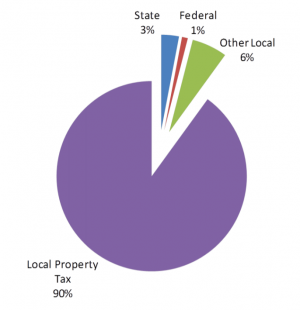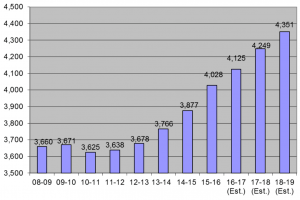District Approves 2016-2017 Budget

In June, the MVLA School Board approved the 2016-2017 budget, which funds all district services, including teacher salaries, campus facilities and programs for the three schools.
The influx of students into the district had significant impact in this year’s budget. Only two years ago, there were 3,877 students enrolled. This year, there will be an estimated 4,125 students in the district.
“The biggest impact [of] increasing enrollment is the need to hire more teachers, which of course costs money,” Associate Superintendent Mike Mathiesen said. “We have already included in our budget the additional teaching staff required to accommodate the enrollment growth through 2017-18.”
District revenue and spending both increased by about 12 percent to $78 million and $72.6 million, respectively. The budget allocates 85 percent of expenditures on employee salaries and benefits, and the other 15 percent represents expenditures on books, supplies, services and other operating expenses.
Local property taxes comprise 90 percent of this year’s budget. The district revenue increases continue to exceed expectations with property tax gains forecasted at 10 percent, 3 percent higher than forecasts of 2015-2016.

While future economic projections look promising, the district still holds 5 percent of the its general fund as a reserve to account for market volatility. The district kept this reserve at the board-approved minimum of 5 percent in the last two years, though it continues to grow alongside the overall budget. This reserve allows the district to be flexible in case the economy dips unexpectedly or when local tax revenue falls.
Overall staffing expenditures for the 2016-2017 school year grew by 13 percent compared to last year. Total spending on salaries increased similarly by 12.5 percent to around $44.6 million from $39.6 million, which included money for two new counselors, two student services coordinator positions, and additional mental health services.
Further changes to the budget include reductions to the Career Technical Education (CTE) funding, money which provides students a pathway to higher education and careers. The program will be phased out over the next two years due to changes in statewide funding.
“Two years ago, when the state school funding formula changed, the state did away with money for specific programs, like CTE,” Mathiesen said. “Even though the county continued to receive the same dollar amount from the state, which included the dollars formerly designated for CTE, the county decided to no longer pass those dollars on to the district since they were no longer restricted just to be used for CTE programs.”

Although the loss of CTE funding will decrease revenue, a separate CTE Incentive Grant provided the district with more than $500,000, which will be used to expand the Freestyle program.
“The CTE grant was written specifically to expand Freestyle,” said Associate Superintendent Brigitte Sarraf. “We are not planning on funding any other program with [it].”
Summer construction at the school, including locker room renovations and the construction of a fitness center, cut into the district’s funds. Increased spending was also used to fund energy efficiency projects, targeting heating, cooling and lighting systems. Expenditures from the district’s building fund and capital facilities fund totalled $6.4 million, surpassing the $1.2 million estimate in the 2015-2016 budget.
With the multi-year projection, the district is able to set its current operational needs based on the future. Nevertheless, the budget allows leeway so that the district can maintain stability even when estimates do not reflect reality.



